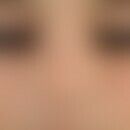Synonym(s)
DefinitionThis section has been translated automatically.
Endogenous, mostly unilateral, neurotropic recurrent infection with the varicella zoster virus (HHV-3; see below herpes viruses, human). In contrast to varicella, zoster (zoser from the Greek zostrix = girdle) is a disease of older people and is one of the most common acute diseases in dermatology.
ClassificationThis section has been translated automatically.
Depending on the localisation, a further distinction is made:
You might also be interested in
Occurrence/EpidemiologyThis section has been translated automatically.
The incidence of zoster is increasing worldwide.
In Germany, around 350,000 - 400,000 people fall ill every year, around 2/3 of whom are > 50 years old.
Incidence in 0-14 year olds: 0.45/1000 inhabitants/year.
In a larger collective, Germany found an average incidence of 5.79 per 1000 persons/year.
Incidence in persons > 50 years: 9.6/1000, between 60-70 years: 9-11/1000, >80 years: 13/1000 persons/year.
Noteworthy is the increase in hospitalized zoster cases of all ages from 2009-2019 (collective of the Essen Dermatology Clinic) by around 57.5% (Lebedeva V et al. (2022).
EtiopathogenesisThis section has been translated automatically.
Reinfection with the varicella zoster virus in the case of partial immunity as a result of humoral immunization that has taken place or reactivation of the virus present in the body due to a reduction in resistance.
Trigger factors for zoster infection are chemical, physical or actinic stimuli, chronic stress, malignancies, immunosuppressive therapy and HIV infection.
If the specific defense directed against VZV falls below a critical level, viral replication in the afflicted ganglion, inflammatory symptomatology with neuronal necrosis and pain occur. With the development of sensory neuritis, infectious virus particles are transported within the affected nerve into the skin, where they lead to the classic vesicular and blister-forming zoster symptomatology.
Diseases associated with an increased risk of zoster (Wollina U 2018):
- Immunodeficiencies: incidence rate in all forms of immunodeficiencies (incidence rate increased 2-fold). Nearly 50% of patients with bone marrow transplants develop zoster, as well as about 20% of HIV-infected patients, depending on their immune status. Similarly, an increased incidence rate is found in patients on immunosuppressants and biologics.
- Severe psoriasis HazardRatio: 1.61
- Cancer (adults) Odds Ratio: 2.46
- Rheumatoid arthritis: odds ratio 1.95-2.30
- Celiac disease: Hazard ratio: 1.62
ManifestationThis section has been translated automatically.
Occurs mainly in older age and in immunocompromised patients. Zoster infections in the newborn are rare. Women become ill more often than men.
LocalizationThis section has been translated automatically.
Mostly one-sided (segmental zoster), very rarely double-sided (zoster duplex). Basically all dermatomes can be affected.
Most frequently, however, the zoster affects thoracic segments (zoster thoracicus - about 50%); 20% affect the innervation areas of cranial nerves - here the innervation areas of N.V. (especially its first branch, the ophthalmic nerve) and less frequently of N. VII and N. VIII are affected.
Less frequently, in descending order, the cervical, lumbar and sacral segments are affected, most frequently in supply area T3, L3.
ClinicThis section has been translated automatically.
Incubation period 7-18 days. Uncharacteristic prodromal stage lasting 2-5 days with slightly elevated temperature. Rarely zoster fever. Tingling, burning and stabbing, shooting pains can occur even before the skin symptoms.
The zoster rash is unilateral and segmental. Initially, discrete red patches appear, which confluent into unilateral, painful, extensive patches.
Within 12-24 hours, grouped papules appear on the red patches, rapidly transforming into initially clear, later cloudy vesicles/blisters and pustules.
The zoster blisters usually dry up within 7-12 days, forming crusts. The lesions heal without scarring in immunocompetent people. Hypo- or hyperpigmentation is possible.
Zoster pain: As sensory nerves are predominantly affected, pain (even more so than the actual skin symptoms) is the main clinical symptom reported by many sufferers.
- The acute zoster pain, which is described as burning or stinging, often begins 4-5 days before the vesicle eruption. It persists for 4-5 weeks and often requires treatment (anti-inflammatory drugs).
- Chronic zoster pain(post-zosteric neuralgia = persistence of pain > 4 weeks after the skin lesions have healed). The formerly affected areas of skin remain hypersensitive(allodynia), so that, for example, tight-fitting clothing is not tolerated. In more severe cases, there are reports of excruciating permanent pain, which can also occur in attacks and lancinating.
Delayed healing with scarring is observed in older people and those with immune incompetence.
Hemorrhagic coloration of the zoster blisters and vesicles(hemorrhagic-necrotic zoster) is rare.
Segmental paresis: in addition to the afferent branch, the motor branch of the nerve can also be affected by VZV infection. The consequences are segmental paresis.
Zoster oticus: risk of facial nerve palsy.
Zoster sine herpete: reactivation of VZV without any skin manifestation. Mostly diffuse pain in the affected dermatome.
Scarring especially with necrotizing zoster.
Special forms:
- Zoster multiplex unilateralis
- Zoster ophthalmicus
- Zoster in the trigeminal area (2nd and 3rd trigeminal branch)
- Cranial zoster (cranial zoster: patients with affections of head or neck nerves (headache, neck stiffness, lymphadenopathy)
- Zoster oticus
- Zoster generalisatus
- Ramsay-Hunt syndrome (in addition to the facial nerve, the vestibulocochlear nerve is also affected. Tinnitus, dizziness and hearing loss are possible).
DiagnosticsThis section has been translated automatically.
As a rule, the typical medical history and clinical manifestations are sufficient for a diagnosis.
In some cases, extended diagnostics may be useful. Viruses can be detected from vesicle secretions using PCR. If herpes encephalitis is clinically suspected, a lumbar puncture is mandatory. CAVE: Emergency imaging (cMRI, cCT) must be performed in case of neurological acuteity and clouding of consciousness.
Patients under 50 years of age should be offered an HIV examination. In addition, a small tumor search can be performed.
Further necessary diagnostic measures ei:
- Zoster ophthalmicus: Consultation with an ophthalmologist to rule out eye involvement (e.g. neuritis, acute retinal necrosis)
- Zoster oticus: Interdisciplinary treatment with the ENT department and neurologist, especially if cranial nerves are affected
- Zoster sine herpete: Serology from serum, plasma or nasopharyngeal swab may be considered.
LaboratoryThis section has been translated automatically.
The routine laboratory shows no special features in an uncomplicated course.
Virus DNA can be detected in body fluid and tissue by polymerase chain reaction.
Retrospectively, VZV serology is of importance. Antibodies of the IgG, IgA and IgM classes indicate reactivation by increasing.
HistologyThis section has been translated automatically.
Differential diagnosisThis section has been translated automatically.
Erysipelas: flat, bizarrely limited, painful red plaque, fever, lymphadenopathy
Herpes simplex: the zosteriform herpes simplex infection is an important differential diagnosis. Mostly small blisters and small foci.
Zoster generalisatus: varicella; the zoster generalisatus still shows a segmental infestation pattern.
In zoster sine herpete: neuralgia (DD in facial nerve palsy)
Complication(s)(associated diseasesThis section has been translated automatically.
Ulcers: On the skin in the acute stage, mainly bacterial secondary infections, sometimes with ecthyma-like ulcers. Other important dermatological complications are hemorrhages (hemorrhagic zoster), circumscribed or extensive necrosis ( zoster gangraenosus), persistence of pain symptoms.
Scars: Chronic, disturbing sequelae on the skin are hypo- and depigmented scars, hypesthesia or hyperesthesia.
Isotopic reactions: Less common are isotopic reactions (= appearance of a second skin disease at the same site after healing of the primary skin lesions) such as acneiform reactions, lichen planus, circumscritic scleroderma, granuloma anulare, tuberculoid and sarcoid infiltrates, granulomatous vasculitides, and lymphomas.
Zoster react ivations: In very rare cases, zoster reactivations have been observed, such as after COVID vaccinations (Gambichler T et al. 2022).
Ophthalmologic complications: These include eyelid skin lesions with subsequent scarring, conjunctivitis, episcleritis, scleritis, keratitis, endothelitis, uveitis with the risk of secondary glaucoma, What is feared is acute retinal necrosis. Chorioretinitis and neuritis of the optic nerve are complications more frequently observed in AIDS patients. Zoster involvement of the nasal slope and bridge due to involvement of the nasociliary branches of the ophthalmic nerve is considered a Hutchinson's sign.
Otologic complications: These involve the so-called Ramsay-Hunt syndrome. Ramsay-Hunt syndrome is a triad of.
- Painful vesicles in the external auditory canal and on the pinna of the ear.
- Ear pain
- Ipsilateral peripheral facial nerve palsy
Neurologic complications:
- They include zoster meningitis and zoster encephalitiss, motor neuropathies and paralysis, Guillain-Barré syndrome, granulomatous arteritis, and cranial nerve deficits.
- Postzosteric neuralgia: The most common and important complication is acute and chronic pain (see zoster neuralgia below). This complication occurs in about 20% of zoster patients.
- Segmental paralysis in the wake of zoster is possible but rather rare.
- The risk of developing Parkinson's disease postzoster is documented with a hazard ratio of 1.17.
Urologic complications: Cystitis, which often goes undiagnosed.
Vascular complications: The risk of vascular disease such as TIA (G45.92), apoplexy (I64), and ischemic myocardial infarction (I21.9) is significantly increased in the first 3 months after the onset of zoster disease. The risk of peripheral arterial occlusive disease (CAD) has a hazard ratio of 1.3; that of giant cell arteritis, a hazard ratio of 1.99-2.16.
Postzoster cancer risk: Highest incidence 180 days after herpes zoster diagnosis. Lymphoma Leading. Relative risk for cancer ranges from 1.42-1.83 (Wollina U 2018).
General therapyThis section has been translated automatically.
Treatment goals include the reduction of complications (e.g. dissemination), the containment of acute pain and the prevention of chronic, zoster-associated pain. Early use of antivirals (especially in patients > 50 years of age, with immunosuppression, with zoster in the head area) within 72 hours of the appearance of the first skin changes.
Pain medication for acute zoster pain: Gradual medication in collaboration with the pain therapist. As a general rule, the earliest possible treatment of acute pain symptoms should be sought to prevent the pain from becoming chronic!
- Grade 1 of the WHO pain scale: Starting with paracetamol (e.g. Ben-u-ron) 3-4 times/day 500 mg or non-steroidal anti-inflammatory drugs such as indomethacin (e.g. Amuno) 50-150 mg/day p.o. or ibuprofen (e.g. Ibuprofen-ratiopharm) 2 times/day 800 mg p.o. Alternatively: Naproxen (e.g. Proxen) 2 times/day 500 mg or acetylsalicylic acid (e.g. ASA) 3-4 times/day 0.5-1.0 g or metamizole (e.g. Novalgin) 1-4 times/day 500-1000 mg p.o.
- Grade 2 on the WHO pain scale: low-potency opioids such as tramadol 200-600 mg 1 time/day or tilidine plus naloxone 300-600 mg 1 time/day. If necessary, combinations of low-potency opioids with so-called "co-analgesics" such as amitriptyline 1 time/day 20-50 mg p.o., gabapentin 1 time/day 900-2400 mg, clonazepam 1 time/day 1.0-3.0 mg or nerve blocks.
- Grade 3 of the WHO pain scale: High-potency opioids, individually in combination with coanalgesics. Morphine initially 1-2 times/day 5.0-20 mg or buprenorphine 1 time/day 0.8-4.0 mg or sympathetic blockade.
Glucocorticoids: Controversial in the initial phase, rapid improvement of inflammation and reduction of pain once the vesicle stage has subsided. Initially high, then decreasing dosage, e.g. 20-60 mg prednisolone equivalent/day p.o.
Post-zosteric neuralgia: see below zoster neuralgia.
According to the criteria of the G-AEP - German Appropriateness Evaluation Program - the indication for hospitalization of a zoster patient is given if intravenous medication is indicated due to the severity of the disease (see also Lebedeva V et al. 2022)
External therapyThis section has been translated automatically.
In uncomplicated cases and/or as an adjunct to systemic antiviral therapy:
- Moist compresses, antiseptic, drying, tanning therapy with oak bark extract (Tannosynt; Tannolact) or with 2-3% Clioquinol in Lotio alba R050 (not on the face), there Clioquinol cream (e.g. Linola-Sept, R049 )
Note! Do not use Clioquinol on the hairy head, it turns gray hair yellow! Alternatively, cooling antiseptic gels such as polyhexanide gel 0.02 or 0.04% (NRF 11.128) or gels containing octenidine can be used. Black tea compresses are a simple and readily available prescription.
Topical antibiotics should no longer be used. Softening ointments such as dexpanthenol (e.g. Bepanthen) after the blisters have dried.
- Externals with a virustatic additive: 5% idoxuridine solution/ointment (e.g. Zostrum, Virunguent) applied thinly 4 times/day to the diseased skin areas (this therapy is described by many authors as ineffective and dispensable (see below Wollina U 2018).
Internal therapyThis section has been translated automatically.
For milder courses: Acyclovir per os (e.g. Zovirax®) 5 times/day 800 mg p.o. for 7-10 days.
- Alternatively Valaciclovir (Valtrex®): 3 times/day 1000 mg p.o. over 7 days. Valaciclovir has a significantly higher bioavailability of around 65% than acyclovir.
- Alternatively Famciclovir (Famvir®): 3 times/day 250 mg p.o. over 5-6 days. Famciclovir has a bioavailability of 77%. Significantly better antiviral activity. Compliance advantage due to daily single dose. For immunosuppressed patients from the age of 25 and for herpes zoster ophthalmicus: 3x500mg/day.
- Alternatively brivudine (tablets only in the early phase of infection): Immunocompetent adults: 1x/day 125mg p.o. over 7 days; brivudine must not be administered together with 5-fluorouracil or other 5-fluoropyrimidines within the last 4 weeks (absolute contraindication). Brivudine is only a treatment option in the initial phase of the infection. Treatment should be started within 72 hours of the first symptoms appearing.
In severe cases (systemic acyclovir): In severe cases (haemorrhagic/necrotizing), in head and neck infections and in immunocompromised patients: Aciclovir (e.g. Zovirax®) 10.0 mg/kg bw every 8 hours for 5-7 days i.v. In case of CNS and internal organ involvement or generalization, the dose can be escalated to 3x15 mg/kg bw/day for up to 21 days.
In case of superinfection: Antibiotic cover only if secondary infections are suspected in severe forms of the disease or in elderly, infection-prone or immunocompromised patients. Choice of antibiotic according to antibiogram.
In pregnancy: Zoster disease during pregnancy (mother is seropositive) is due to reactivation of a latent VZV infection. With the exception of generalized zoster, there is no viremia. There is therefore no significant risk for mother and child. Therapy is not necessary. In complicated zoster (zoster in atopic eczema, zoster oticus, zoster ophthalmicus, zoster generalisatus) systemic administration of acyclovir (3 times/day 10-20 mg/kg bw i.v.).
In case of varicella-zoster contact during pregnancy: determine AK status (VZV ELISA). IgG < 1:64 or seronegative: administration of varicella-zoster immunoglobulin (Varitect or Varicellon) Varitect: 1.0 ml/kg bw i.v. within 24-72 hours after contact. Varicellon is to be dosed at 0.2 ml/kg bw i.m.
In rare neonatal infections, acyclovir is administered p.o. (40-80 mg/kg bw/day) or i.v. (30 mg/kg bw/day).
Note - Glucocorticoids: Systemic glucocorticoids are not indicated except in zoster oticus and zoster ophthalmicus.
Zoster pain: In zoster-associated pain, the patient's subjective perception of pain should be assessed using a visual analog scale (VAS) or numerical rating scale (NRS) and treated accordingly in order to reduce the likelihood of post-zosteric neuralgia. The neuropathic pain can be treated with anticonvulsants such as gabapentin or pregabalin. Tricyclic antidepressants such as amitryptiline have also proven to be effective. It is important to adjust the dosage to kidney function, side effects such as tiredness, dizziness, drowsiness, drowsiness, control of glucose and pancreatic enzymes in the serum. Dosage: Pregabalin: Initially 2 x 25 mg p.o., increase every 1-2 days by 25 mg, adapted to tolerability up to max. 2 x 300 mg/day
- Gabapentin: Initial: 300 mg at night or 3 x 100 mg/day Increase after 3-4 days by 300 mg (3 x 100 mg spread over the day), maximum dose: 3 x 1200 mg
Progression/forecastThis section has been translated automatically.
Healing after 2 to 3 weeks, usually leaving lifelong immunity. However, some patients develop several episodes of zoster. These patients are likely to benefit from vaccination. It is recommended to vaccinate older patients 6 months after a zoster infection.
ProphylaxisThis section has been translated automatically.
The results of a vaccine "Zostavax" in a large group of older people (>60 years) showed a significant reduction in cases of the disease (reduction of 55% compared to a non-vaccinated control group). The vaccine contains VZV of the Oka/Merck strain, but in a 14-fold higher dosage than in the chickenpox vaccine. The preparation has been available in Germany since 2013 (approved for adults aged 50 and over) and is approved in more than 60 countries. A booster is recommended after 10-30 years. The incidence of zoster is reduced by 97% regardless of age.
From 2008, the vaccine was recommended in the USA for all (immunocompetent) persons > 60 years of age. Zoster vaccination is particularly recommended for multimorbid patients, as pain and psychosocial consequences (including post-zosteric neuralgia) can be avoided (Meier K et al. 2017).
Inactivated vaccine Shingrix®: In immunocompromised patients (HIV infection, treatment with immunosuppressive biologics), the adjuvanted inactivated vaccine Shingrix has been available since 2018 as a highly effective therapeutic agent that offers long-lasting, age-independent protection against zoster and zoster neuralgia. The preparation was used in a phase III study program in 38,000 patients worldwide. It should be used as early as possible in zoster infections. The intramuscular injections are administered twice at intervals of 2 (possibly 6) months. People who develop herpes zoster despite vaccination with the inactivated vaccine have significantly less pain and fewer restrictions in their daily activities in the event of illness.
Shingrix is recommended by the STIKO as a standard vaccination for all people aged 60 and over to prevent herpes zoster and its complications and late effects. The Shingrix vaccination is also recommended for congenital or acquired immunosuppression and/or severe underlying diseases from the age of 50.
- Side effects of Shingrix: >90% of all vaccinated persons develop pain at the injection site. Almost all local reactions subside completely within 3 days. About 2/3 of those vaccinated develop mild systemic reactions such as: fatigue (75.3%), myalgia (74%), headache (64%), less frequently back pain, chills and symptoms of a flu-like infection.
- Since August 2020, the EU Commission (EMA) has extended approval for people with an increased risk of zoster from the age of 18 and all people aged 50 and over. Since November 2025, the STIKO has also recommended this for people aged 18 and over with an increased health risk.
NaturopathyThis section has been translated automatically.
TablesThis section has been translated automatically.
Treatment of varicella zoster infection in HIV patients (after Brodt, Helm, Kamps, Aids 2000, Steinhäuser Verlag)
Indication |
Drug |
Dosage/Application |
CD 4 > 200/μl - only one dermatome affected |
Aciclovir (e.g. Zovirax) |
5 times/day 12 mg/kg bw p.o. = 5 times/day 1 tbl. at 800 mg p.o. |
Famciclovir (Famvir) |
3 times/day 250 mg p.o. |
|
valaciclovir (Valtrex) |
3 times/day 1000 mg p.o. |
|
Brivudine (helpin) |
4 times/day 125 mg p.o. over 7 days. |
|
CD 4 < 200/μl and/or several dermatomes affected or disseminated infestation or trigeminal infestation |
Aciclovir |
3 times/day 10 mg/kg bw i.v. = 34 times/day 500 mg i.v. in 500 ml NaCl solution over 10 days. |
For acyclovir resistance |
Foscarnet (Foscavir) Use only if kidney function is intact, check kidney parameters! |
3 times/day 40 mg/kg bw i.v. = 3 times/day 2400 mg i.v., each time infuse 100 ml in glucose solution 5% or NaCl solution diluted to 500 ml over 1 hour. Duration of therapy: Until the symptoms subside. |
Note(s)This section has been translated automatically.
Shingles is considered an early marker of HIV infection. Therefore, the German guideline recommends HIV serology in otherwise healthy patients under 50 years of age with zoster infection.
Important distinguishing features of zoster infection compared to other exanthema are:
- the asymmetry (segmental pattern) of the zoster infestation,
- the synchronous development of the skin lesions (in contrast to herpes simplex, whose vesicles can be in different stages of development)
- The phased sequence of efflorescences, beginning with erythema, followed by vesicles, pustules and crusts.
- Varicella-like exanthema is particularly common in AIDS patients and other immunologically incompetent patients. The synchronous isomorphism of zoster infestation is often absent here.
According to § 6(1) No. 1 of the Infection Protection Act (IfSG), suspected cases, illness and death from varicella must be reported by name to the responsible health authority.
LiteratureThis section has been translated automatically.
- Breuer J et al. (2014) Herpes zoster as a risk factor for stroke and TIA: a retrospective cohort study in the UK. Neurology 83:e27-33.
- Cunningham AL et al. (2016) ZOE-70 Study Group. Efficacy of the Herpes Zoster Subunit Vaccine in Adults 70 Years of Age or Older. N Engl J Med 375:1019-1032.
- Enright AM et al. (2003) Antiviral therapy in children with varicella zoster virus and herpes simplex virus infections. Herpes 10: 32-37
- Furuta Y (2005) Varicella-zoster virus reactivation is an important cause of acute peripheral facial paralysis in children. Pediatr Infect Dis J 24: 97-101
- Gambichler T et al. (2022) Cutaneous findings following COVID-19 vaccination: review of world literature and own experience. J Eur Acad Dermatol Venereol 36:172-180.
- Gesierich A et al. (2005) Post-zosteric granulomatous dermatitis with detection of varicella-zoster virus DNA. J Dtsch Dermatol Ges 2: 770-772
- Hambleton S (2005) The impact of varicella vaccination in the United States. Semin Pediatr Infect Dis 16: 38-43
- Kempf W et al. (1999) Infections with varicella zoster virus. Dermatology 52: 359-376
- Lal H et al (2015) ZOE-50 Study Group. Efficacy of an adjuvanted herpes zoster subunit vaccine in older adults. N Engl J Med 372:2087-2106.
- Lebedeva V et al. 2022) Increase in inpatient cases of zoster in Germany: Possible causes and recommendations for prevention. J Dtsch Dermatol Ges 20: 694-696.
- Lilie HM, Wassilew SW (2004) Varicella-zoster virus infections. Dermatologist 55: 831-84
- Meier K et al. (2017) Benefit of zoster vaccination in elderly patients. Dermatologist 68: 418-419.
- Müllegger RR et al (2010) Skin infections in pregnancy. Dermatologist 61: 2066-2069
- Tseng HFet al. (2011) Herpes zoster vaccine in older adults and the risk of subsequent herpes zoster disease. JAMA 305: 160-166
- Tricco AC et al.(2018) Efficacy, effectiveness, and safety of herpes zoster vaccines in adults aged 50
- and older: systematic review and network meta-analysis. BMJ 363: k4029.
- Wollina U (2018) Recognizing herpes zsoter quickly and treating it efficiently. hautnah 34: 32-35.
- Vazquez M, Shapiro ED (2005) Varicella vaccine and infection with varicella-zoster virus. N Engl J Med 352: 439-440.
- Werner RN,. Herpes zoster - Prävention, Diagnostik und Behandlung [Herpes zoster-prevention, diagnosis, and treatment]. Dermatology. 73: 442-451.
- Müller CSI et al (2021) Herpes zoster update-what's new? Act Dermatol 47: 498-509.
- Schmidt SAJ et al. (2021) Perceived psychological stress and risk of herpes zoster: a nationwide population-based cohort study. Br J Dermatol. 185: 130-138.
- Wilms L et al. (2022) Infections with herpes simplex and varicella zoster virus. J Dtsch Dermatol Ges 20:1327-1353.
- https://www.aerzteblatt.de/news/stiko-andert-impfempfehlung-fur-herpes-zoster-96a2e57a-f3d5-4d44-b556-2a8bbb8ad71d
- https://www.rki.de/DE/Aktuelles/Publikationen/Epidemiologisches-Bulletin/2025/45_25.pdf?__blob=publicationFile&v=4
Incoming links (58)
Allodynia; Anetoderma; Blepharitis; Blueberry muffin baby; Blueberry muffin baby; Bubbles; Chronic lymphocytic leukemia; Chronic lymphocytic thyroiditis; Collagenosis reactive perforating; Cortisone acetate; ... Show allOutgoing links (43)
5-Fluoropyrimidine ; Aciclovir; Acupuncture; Allodynia; Brivudin; Celiac disease; Circumscribed scleroderma; Clioquinol; Clioquinol cream 0.5-2% (o/w); Clioquinol lotio 0.5-5%; ... Show allDisclaimer
Please ask your physician for a reliable diagnosis. This website is only meant as a reference.
Images (33)
Articlecontent
- Definition
- Classification
- Occurrence/Epidemiology
- Etiopathogenesis
- Manifestation
- Localization
- Clinic
- Diagnostics
- Laboratory
- Histology
- Differential diagnosis
- Complication(s)(associated diseases
- General therapy
- External therapy
- Internal therapy
- Progression/forecast
- Prophylaxis
- Naturopathy
- Tables
- Note(s)
- Literature
- References
- Authors





































